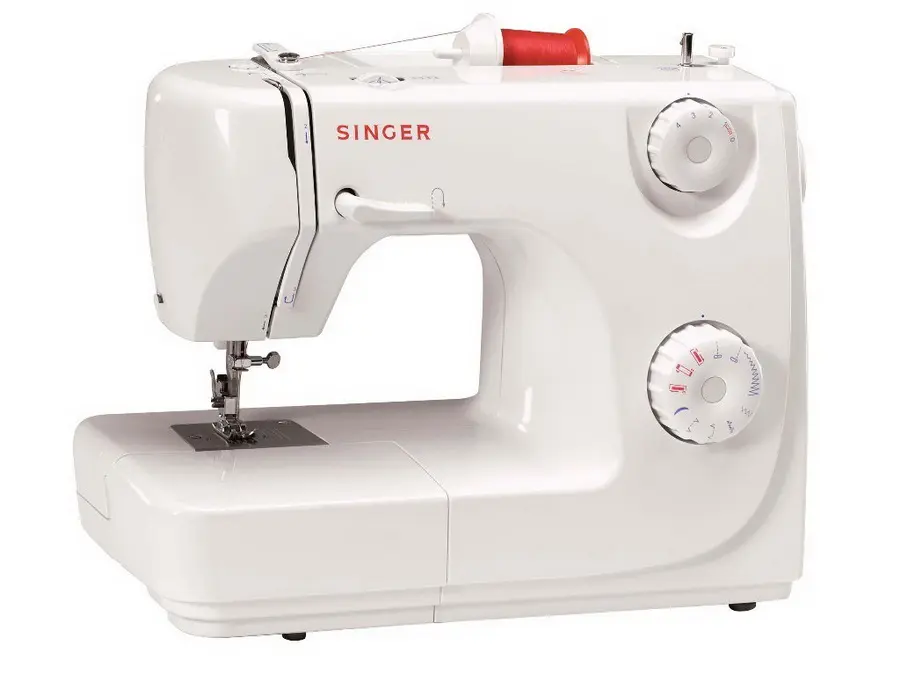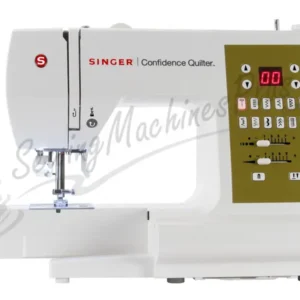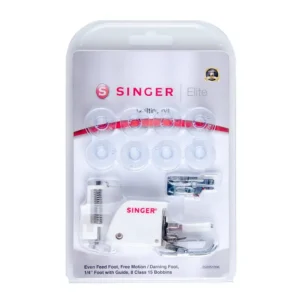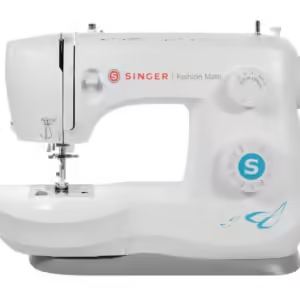Our Singer Prelude 8280 review explores user-friendly sewing machine, well-suited for beginners and casual sewers. It offers basic features at an affordable price, making it a good choice for learning the ropes or tackling straightforward sewing projects. While the stitch selection is limited, the automatic tension, built-in features, and portable design make it a convenient and reliable option for everyday sewing needs.
Stitching Versatility:
- 7 Built-in Stitches: While not the most extensive selection, this machine offers basic stitches for essential sewing tasks like straight stitching, zigzag, and blind hem. Perfect for mending, alterations, and simple crafts.
- 3 Needle Positions: Allows you to adjust the needle left, center, or right, ideal for topstitching, edge finishing, and zipper insertion.
Convenience and Ease of Use:
- 4-Step Buttonhole: Simplifies creating consistent buttonholes in 4 easy steps, saving time and frustration.
- Front-Loading Class 15 Bobbins: Easy to insert and replace bobbins with clear visibility of thread level.
- Automatic Tension: Ensures balanced stitches for all fabric types without manual adjustments.
- Built-in Accessory Storage: Keeps essential presser feet and tools organized and readily accessible.
- Carry Handle: Lightweight and portable, perfect for taking your sewing on the go or storing conveniently.
- Free-Arm: Narrow sewing surface facilitates sewing sleeves, cuffs, and circular garments.
- Light: Illuminates the sewing area for better visibility and precision.
Additional Features:
- Snap-on Presser Feet: Quick and easy attachment of different presser feet for various sewing techniques.
- Horizontal Thread Delivery: Smooth thread flow for consistent stitch quality.
- Limited Warranty: Provides peace of mind with extended coverage on the machine head (25 years) and decent coverage on other components.
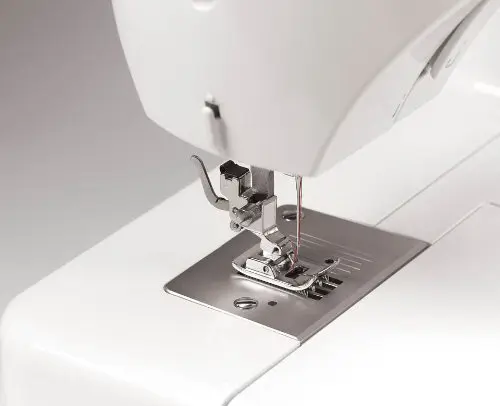
Singer Prelude 8280 Sewing Machine
✭ ✭ ✭ ✭ ✭
Shop now and save with our extended coupon code and flash sale discount! Limited time only, first come first served.
Included Accessories:
Let’s now have Singer Prelude 8280 accessories review that will assist you get started with your sewing projects. Then’s a list of the included accessories and their uses:
- Feed Cover Plate: This plate covers the feed dogs, which support to move the fabric through the machine. It’s removed when operating certain presser feet, such as the zipper foot and buttonhole foot.
- Zipper Foot: This foot is used to sew zippers. It has a narrow channel that guides the zipper teeth, and it can be adjusted to sew close to the zipper teeth.
- Buttonhole Foot: This foot is used to sew buttonholes. It has a special guide that helps you create evenly spaced buttonholes.
- Button Sewing Foot: This foot is used to sew on buttons. It has a raised platform that helps you to position the button rightly.
- General Purpose Foot: This is the most universal foot that comes with the machine. It can be used for a variousness of sewing tasks, analogous as straight stitching, zigzag stitching, and topstitching.
- Needles: The machine comes with a assortment of needles, which you can change depending on the fabric you’re sewing.
- Bobbins: Bobbins are small spools of thread that are inserted into the bobbin case. What’s more the machine comes with a many bobbins, but you’ll need to buy more as you sew.
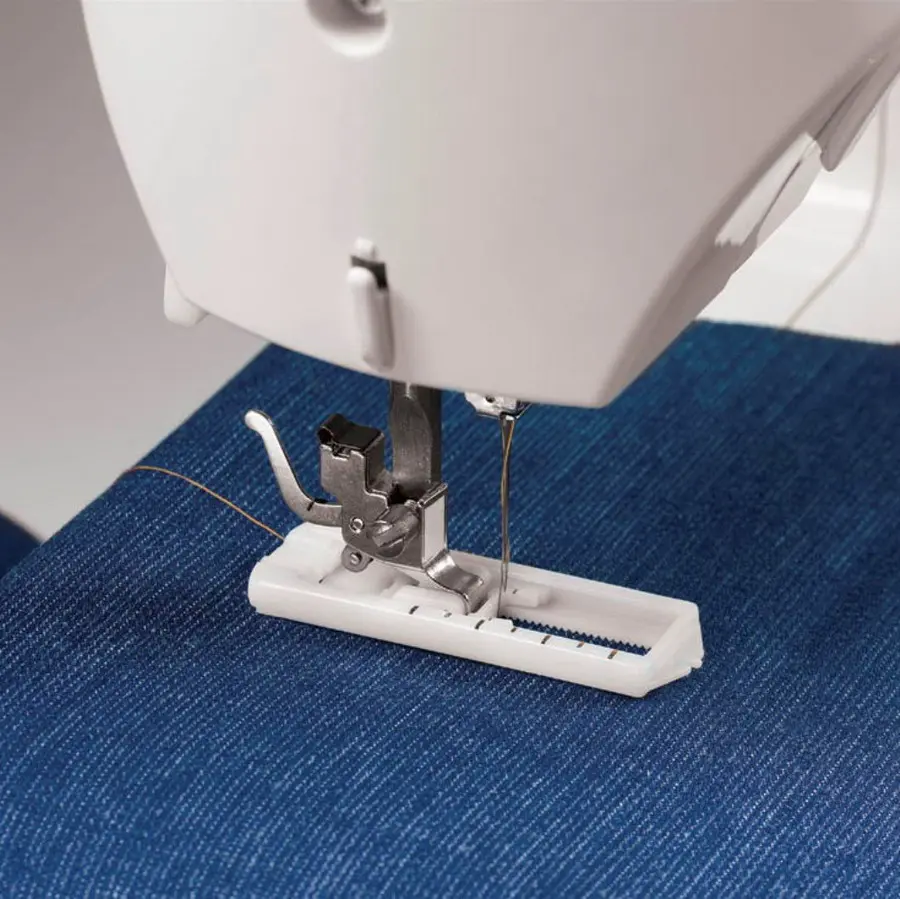
Some others accessories:
- Buttonhole Opener/Brush: This tool is used to open up buttonholes and clean out any lint or thread that may be stuck in them.
- Seam Guide: This guide can be attached to the machine to help you sew straight seams.
- Oil: The machine needs to be oiled sometimes to keep it running smoothly.
- Screwdriver (large): This screwdriver is used to make adjustments to the machine.
- Spool Cap (large): This cap fits on the large spool of thread.
- Spool Cap (small): This cap fits on the small spool of thread.
- Dust Cover: The dust cover helps to protect the machine from dust and dirt when it isn’t in use.
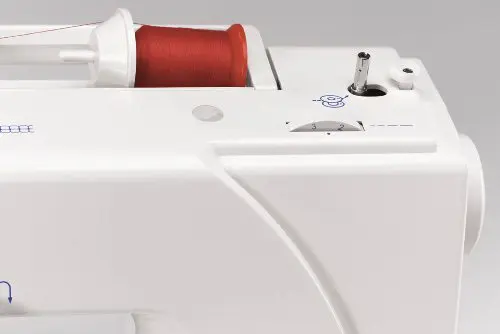
Singer Prelude 8280 Overview Videos:
Hp
How Singer Prelude 8280 Customers review it:
- “I haven’t used it yet but the little sewing machines!” – November 19, 2023 by Deborah S. (Illinois, United States)
- “Scissors are great!” – August 15, 2022 by Jason K. (CA, United States)
- “Kai scissors are perfect for fabric cutting” – February 14, 2022 by Jason (CA, United States)
- “I cannot locate the list of parts.” – February 20, 2021 by Anonymous
- “Love mine!” – August 15, 2020 by KAY
- “As much as I love using a rotary cutter there are times it is better to use a scissors. The Kai scissors are the best scissors I have ever owned.” – July 30, 2020 by Lois E. (WI, United States)
- “I purchased this machine for my daughter. It’s her first sewing machine and she loves it. It is very sturdy and easy to use.” – June 5, 2020 by Kimberly F. (AZ, United States)
- “Love my sewing machine. Thank you!” – June 1, 2020 by Mayah W. (TN, United States) – Great Machine
- “I good working machine for a substitute.” – May 31, 2020 by Jimmie L. (AZ, United States)
- “love my brother” – May 31, 2020 by Bonnie B. (KY, United States)
- “I love this machine and I’m glad I purchased it!!!” – May 31, 2020 by Keyairra G. (TX, United States)
*Read more Singer Prelude 8280 customers reviews at SewingMachinesPlus

